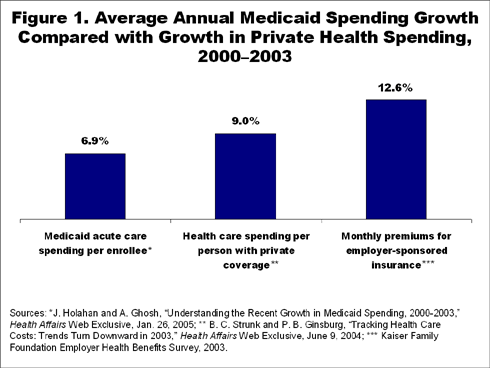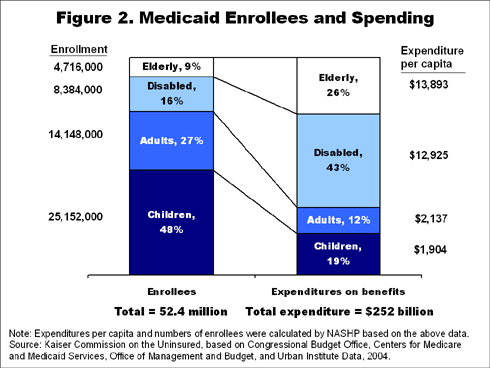Introduction
Medicaid, enacted in 1965, is the nation's health care program for low-income families, elders, and people with disabilities. It is administered by the states, with federal oversight and shared federal funding. In 2003, Medicaid provided services to more than 52 million people at a total cost of $266 billion.
Medicaid is actually many programs wrapped into one. It provides comprehensive health benefits to poor children, some of their parents, and a small share of other poor adults. It offers necessary health and social support to people with disabilities ranging from severe mental illness and AIDS to spinal cord injury and cerebral palsy. For low-income elders and some people with significant disabilities, Medicaid wraps around Medicare by covering Medicare's premium and cost-sharing requirements and helping to pay for long-term care services; until the recent implementation of Medicare's prescription drug benefit, it also helped low-income Medicare recipients pay for prescription drugs. Medicaid also provides financial support to safety-net providers that serve the uninsured through the Disproportionate Share Hospital (DSH) program and other mechanisms.
Medicaid has been effective in helping people gain access to needed care. One study found that 75 percent of children in Medicaid or the State Children's Health Insurance Program (SCHIP) had a preventive or well-child health visit within the past 12 months, compared with 46 percent of uninsured children. Another study found that Medicaid helps patients with chronic diseases receive the care they need to prevent their conditions from worsening. Despite these generally positive results, concerns regarding access to services (particularly specialty care and dental care) have nagged the program since its inception.
Medicaid's costs are growing faster than state or federal revenue, but this elevated rate must be viewed in the context of the program's various functions. Medicaid coverage for low-income children and families costs less than private coverage for comparable population, despite the program's comprehensive benefit package and limited cost-sharing. This is primarily because Medicaid pays providers below-market rates, but also because it has lower administrative costs than private health insurance. Indeed, Medicaid's per-person costs for acute services have grown more slowly than per-person costs for health care spending in private insurance and employer-sponsored insurance premiums (Figure 1).

The average cost per disabled Medicaid enrollee exceeds $12,000 (Figure 2). Medicaid provides services that are generally excluded from, or tightly constrained in, private coverage such as attendant care services, durable medical equipment, and physical therapy. The program covers millions of people who are otherwise "uninsurable" due to severe disabling conditions such as schizophrenia, multiple sclerosis, or developmental disabilities.
Forty percent of Medicaid costs are associated with "dual eligibles," people who are covered by Medicare and Medicaid. More than 90 percent of elderly Medicaid recipients are dually eligible, as are about one-third of Medicaid enrollees with disabilities. While about 45 percent of expenditures on behalf of dual eligibles go toward nursing home services, other high-cost areas include home- and community-based services. (Prior to January 2006, Medicaid covered dual eligibles' prescription drugs costs as well.)
